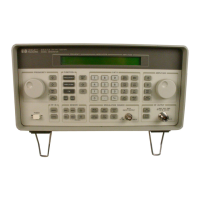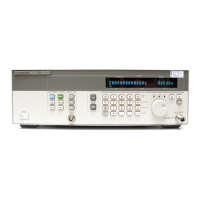8-46
Performance Tests
Internal Timebase: Aging Rate Performance Test (Option 1E5 Only)
Internal Timebase: Aging Rate Performance Test (Option
1E5 Only)
Description
This procedure checks the accuracy of the internal timebase. The time required for a
specific phase change is measured both before and after a specified waiting period. The
aging rate is inversely proportional to the absolute value of the difference in the measured
times.
The overall accuracy of the internal timebase is a function of:
TBC ±AR ±TE ±LE where:
TBC = timebase calibration
TE = temperature effects
AR = aging rate
LE = line effects
After the timebase is adjusted, the timebase frequency should stay within the aging rate if
the following things happen:
• The timebase oven does not cool down.
• The instrument keeps the same orientation with respect to the search’s magnetic field.
• The instrument stays at the same altitude.
• The instrument does not receive any mechanical shock.
If the timebase oven cools (the instrument power switch is set to off), you may have to
readjust the timebase frequency after a new warm-up cycle. typically, however, the
timebase frequency returns to within 1 ±Hz of the original frequency.
NOTE The internal timebase can be tested after reconnecting AC power for
10 minutes, but for best accuracy, test again after the instrument has been on
for 24 hours.
Frequency changes due either to a change in orientation with respect to the earch’s
magnetic field, or to a change in altitude, usually go away when the instrument is returned
to its original position. A frequency change due to mechanical shock usually appears as a
fixed frequency error.

